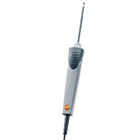Understanding different temperature sensors
Understanding different temperature sensors |
 | In this article we will look into the different types of temperature sensors available. What the strengths and weaknesses of each type of sensor are, and the recommended applications for different types. | |
Accurate temperature measurement is critical for a wide range of industrial and commercial applications. From food safety, to vaccine
storage, and enamel curing, being able to take temperatures is the key to ensuring high quality and safe products. But which
temperature sensor is right for you? We’re going to look at the most popular thermometer types: Thermocouples and RTD's Thermocouples Thermocouples work on a phenomenon known as the Seebeck effect. Each thermocouple is made up of two different types of metal
wires that are joined to form a junction. At this junction, a voltage different is created, and this voltage changes with
temperature. By measuring the change in voltage, the temperature can be determined. You may have seen the terms “type K
thermocouple” or “type T thermocouple”. These different letters designate that a different combinations of metals were
used to make the thermocouple and they each have different sensitivities and different temperature ranges. For example
Type K (Chromel-Alumel) thermocouples are suitable for use up to 1350C and Type T (Copper-Constantan) thermocouples are
suitable for use up to 350C but have higher accuracy than type K. The main advantages of thermocouples are that they can be quite cheap compared to other sensors, and some can be used for very
high temperature applications. The main downside is that the accuracy of them can be much lower than other sensor types.
RTDs RTDs, short for resistance temperature detectors, are another common type of temperature sensor. They work by sending a small current through a small resistor. The resistance of the resistor predictably increases with temperature and as a result, by measuring the change in resistance the temperature can be calculated.
There are two standards for platinum RTDs: the European standard (also known as the DIN or IEC standard) and the American
standard. The European standard, also known as the DIN or IEC standard, is considered the world-wide standard for platinum
RTDs. This standard, DIN/IEC 60751 (or simply IEC751), requires the RTD to have an electrical resistance of 100.00
Ω at 0°C and a temperature coefficient of resistance (TCR) of 0.00385 Ω/Ω/°C between 0 and 100°C. There are two resistance tolerances specified in DIN/IEC751:
Class A = ±(0.15 + 0.002*t)°C or 100.00 ±0.06 Ω at 0ºC Class B = ±(0.3 + 0.005*t)°C or 100.00 ±0.12 Ω at 0ºC Two resistance tolerances used in industry are: 1⁄3 DIN = ±1⁄3* (0.3 + 0.005*t)°C or 100.00 ±0.10 Ω at 0ºC 1⁄10 DIN = ±1 ⁄10* (0.3 + 0.005*t)°C or 100.00 ±0.03 Ω at 0ºC. The combination of resistance tolerance and temperature coefficient define the resistance vs. temperature characteristics
for the RTD sensor. The larger the element tolerance, the more the sensor will deviate from a generalized curve, and
the more variation there will be from sensor to sensor (interchangeability). This is important to users who need to
change or replace sensors and want to minimise interchangeability errors.
The advantages of platinum resistance thermometers include: -High accuracy -Low drift -Wide operating range -Suitability for precision applications. If you’re still unsure about what temperature sensor you need, please contact our scientists on 1300 737 871.
| ||
See our other newsletter articles here!
Contact our expert scientists now to get the right meter or data logger to suit your needs and discuss your project.
Phone: 1300 737 871
Email: [email protected]
